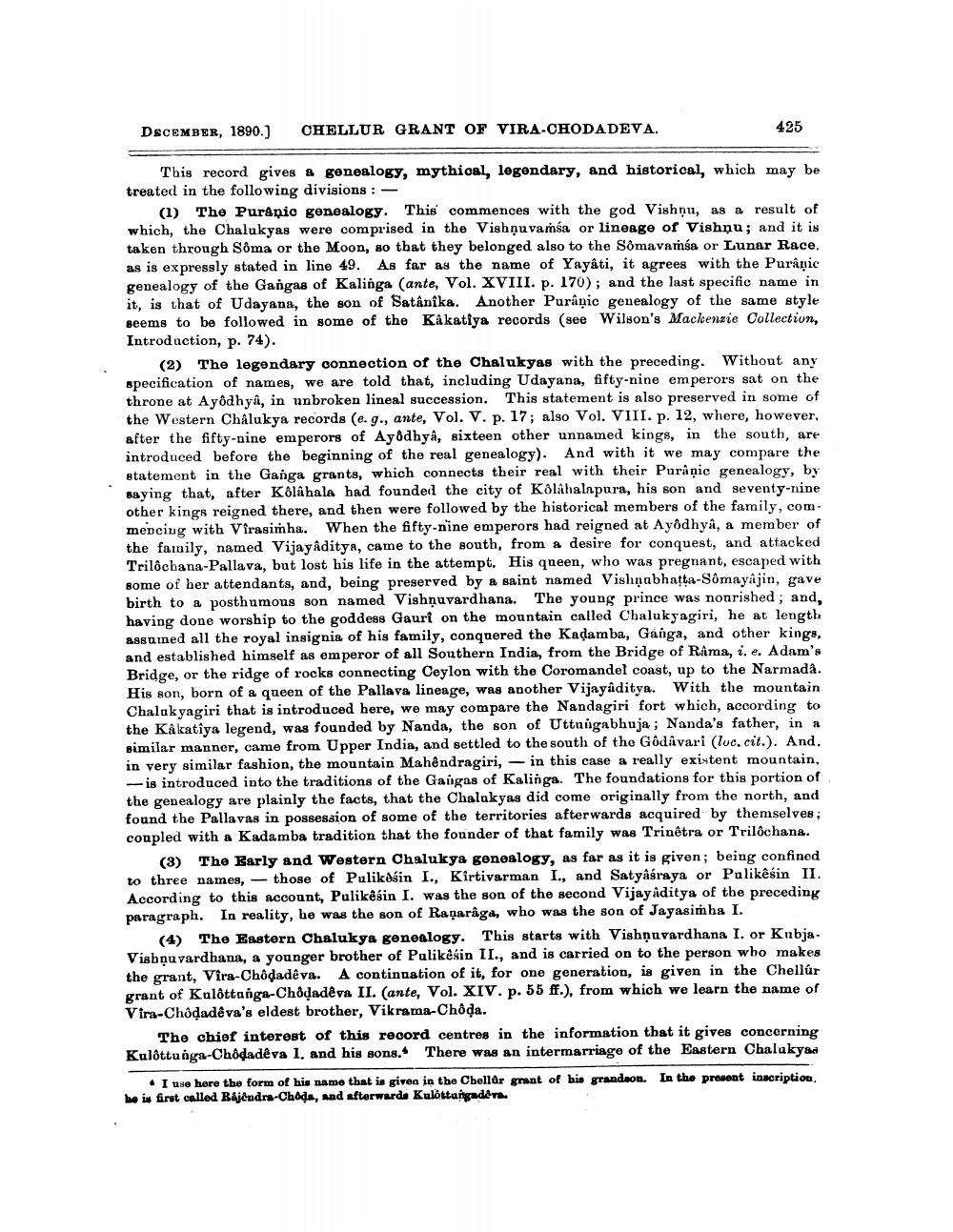________________
DECEMBER, 1890.)
CHELLUR GRANT OF VIRA-CHODADEYA.
425
This record gives & genealogy, mythical, legendary, and historical, which may be treated in the following divisions : -
(1) The Puranic genealogy. This commences with the god Vishnu, as a result of which, the Chalukyas were comprised in the Vishnuvamsa or lineage of Vishnu; and it is taken through Soma or the Moon, so that they belonged also to the Somavamsa or Lunar Race. as is expressly stated in line 49. As far as the name of Yayati, it agrees with the Purâție genealogy of the Gangas of Kalinga (ante, Vol. XVIII. p. 170); and the last specific name in it, is that of Udayana, the son of Satânika. Another Purâņic genealogy of the same style seems to be followed in some of the Kakatiya records (see Wilson's Mackenvie Collection, Introduction, p. 74).
(2) The legendary connection of the Chalukyas with the preceding. Without any specification of names, we are told that, including Udayana, fifty-nine emperors sat on the throne at Ayodhyâ, in unbroken lineal succession. This statement is also preserved in some of the Western Chalukya records (e.g., ante, Vol. V. p. 17; also Vol. VIII. p. 12, where, however, after the fifty-nine emperors of Ayodhyâ, sixteen other unnamed kings, in the south, are introduced before the beginning of the real genealogy). And with it we may compare the statement in the Ganga grants, which connects their real with their Purâņic genealogy, by saying that, after Kölâhala had founded the city of Kôlâhalapura, his son and seventy-nine other kings reigned there, and then were followed by the historical members of the family, commencing with Vîrasimha. When the fifty-nine emperors had reigned at Ayôdhyâ, a member of the family, named Vijayaditya, came to the south, from a desire for conquest, and attacked Trilôchana-Pallava, but lost his life in the attempt. His queen, who was pregnant, escaped with some of her attendants, and, being preserved by a saint named Vishnabhatta-Somayajin, gave birth to a posthumous son named Vishņuvardhana. The young prince was nourished; and, having done worship to the goddess Gauri on the mountain called Chalukyagiri, he at length assuined all the royal insignia of his family, conquered the Kadamba, Ganga, and other kings. and established himself as emperor of all Southern India, from the Bridge of Rama, i.e. Adam's Bridge, or the ridge of rocks connecting Ceylon with the Coromandel coast, up to the Narmadá. His son, born of a queen of the Pallava lineage, was another Vijayaditya. With the mountain Chalak yagiri that is introduced here, we may compare the Nandagiri fort which, according to the Kakatiya legend, was founded by Nanda, the son of Uttnügabhuja; Nanda's father, in a similar manner, came from Upper India, and settled to the south of the Gôdavari (luc.cit.). And. in very similar fashion, the mountain Mahendragiri, - in this case a really existent mountain,
is introduced into the traditions of the Gangas of Kalinga. The foundations for this portion of the genealogy are plainly the facts, that the Chalakyas did come originally from the north, and found the Pallavas in possession of some of the territories afterwards acquired by themselves; coupled with a Kadamba tradition that the founder of that family was Trinêtra or Trilôchana.
(3) The Early and Western Chalukya genealogy, as far as it is given; being confined to three names, - those of Pulikašin I., Kirtivarman I., and Satyåśraya or Palikêśin II. According to this account, Pulikesin I. was the son of the second Vijay aditya of the preceding paragraph. In reality, he was the son of Raqaraga, who was the son of Jayasimha I.
(4) The Eastern Chalukya genealogy. This starts with Vishņuvardhana I. or Kubja. Visbņu vardhana, a younger brother of Palikesin II., and is carried on to the person who makes the grant, Vira-Chôdadêva. A continuation of it, for one generation, is given in the Chellúr grant of Kulôttanga-Chôdadêva II. (ante, Vol. XIV. p. 55 ff.), from which we learn the name of Vira-Chôdadêva's eldest brother, Vikrama-Choda.
The chief interest of this record centres in the information that it gives concerning Kalôttunga-Chôdadêva I, and his sons. There was an intermarriage of the Eastern Chalakya.
I use here the form of his name that is given in the Chelldr grant of his grandson. be is first called Bajēndra-Chods, and afterwards Kulottargader.
In the present inscriptiou,




